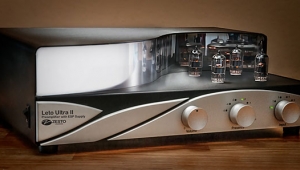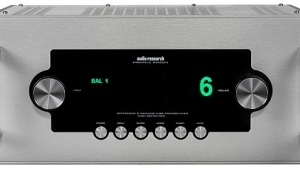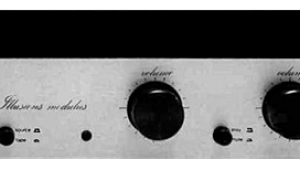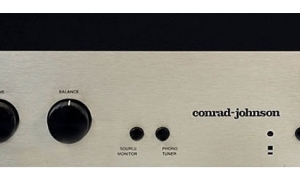| Columns Retired Columns & Blogs |
Balanced Audio Technology VK-51SE line preamplifier Measurements
Sidebar 3: Measurements
The BAT VK-51SE offers a sensible maximum voltage gain (into 100k ohms) of 18.34dB. The volume control operated in accurate 0.5dB steps. Its nominal unity-gain setting actually offered a slight loss of -0.2dB, though this is inconsequential. The preamp preserved absolute polarity, with pin 2 of the XLR jacks wired "hot." The balanced input impedance was extraordinarily high, at more than 1M ohms, though it is hard to be precise because of the very small change in the output voltage when I changed the Audio Precision's source impedance.
The balanced output impedance was twice that specified, at 410 ohms over most of the audioband. This is low, though it did rise to a high 4.7k ohms at 20Hz, due to the size of the output coupling capacitors. (There is only so much room within the chassis for these high-performance but physically large components.) This will not be an issue with components having high input impedances, such as BAT's own power amplifiers, but it does mean prematurely rolled-off low frequencies with low load impedances (fig.1), such as those offered by some solid-state amplifiers.

Fig.1 BAT VK-51SE, frequency response at 1V into 100k ohms (top) and 600 ohms (bottom), both with volume control at unity gain (0.5dB/vertical div., right channel dashed).
Fig.1 was taken with the volume control in its unity-gain position. A very slight but subjectively inconsequential rolloff of -0.5dB can be seen at 20kHz. However, this rolloff depended on the volume-control setting. Fig.2 shows the VK-51SE's response with the control set not only to unity gain, but also to -12dB and +17dB. The ultrasonic rolloff can be seen to be related to the volume control, its highest setting suffering from a -3dB point below 10kHz. However, in almost all systems with normal gain architectures, the volume control will be used at unity gain or below; at such settings, the preamp's response will extend to 20kHz and above.

Fig.2 BAT VK-51SE, frequency response at 1V into 100k ohms with volume control at (from top to bottom): -12dB, unity gain, +17dB (0.5dB/vertical div., right channel dashed).
Channel separation (fig.3) was excellent, at better than 100dB below 1kHz, but worsening above that frequency due to capacitive coupling. It decreased to a still good 70dB at 20kHz from left to right, and 16dB lower in the opposite direction. The preamp's unweighted, wideband signal/noise ratio (with the input shorted and the volume control at its maximum) was an excellent 80.3dB ref. 1V output, this figure improving to 86.2dB when A-weighted.
The BAT preamp both offered excellent linearity and dynamic range. Fig.4 shows how the percentage of THD+noise in the VK-51SE's output varied with the level of a 1kHz tone, both into 100k ohms and into the punishing 600 ohm load. Into the high impedance, the distortion rises out of the noise just below 2V output, but is at a low 0.06%. It rises above that level, but doesn't reach our usual 1% "clipping" point until nearly 34V! Even into 600 ohms, the preamplifier will deliver more than 10V before clipping.
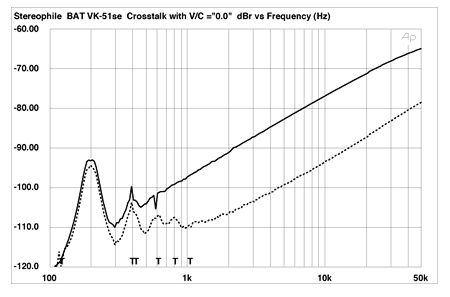
Fig.3 BAT VK-51SE, channel separation with volume control at "0" (10dB/vertical div., R-L dashed).
Fig.5 shows how the distortion level changes with frequency, again into 100k ohms and 600 ohms. The level was 2V, and the distortion into 100k ohms doesn't change with frequency. It does increase at low frequencies into the very low impedance, but not to anything of consequence. (The right channel was very slightly worse than the left; a less-good tube, perhaps?)

Fig.4 BAT VK-51SE, distortion (%) vs output voltage at 1kHz into (from bottom to top at 2V): 100k, 600 ohms.
Into high impedances, the spectrum of the distortion comprised equal but very low levels of second, third, and fourth harmonics (fig.6). Into the low impedance (fig.7), the second rose to -74dB (0.02%) and the third to just above -60dB (0.1%). But, as noted above, the VK51-SE's increasing source impedance at low frequencies makes it unsuitable for driving low impedances, making this behavior moot. Intermodulation distortion into high impedances (fig.8) was very low, rising only slightly into 600 ohms (fig.9).

Fig.5 BAT VK-51SE, THD+N (%) vs frequency at 2V into 100k ohms (bottom) and 600 ohms (top). (Right channel dashed.)

Fig.6 BAT VK-51SE, spectrum of 50Hz sinewave, DC-10kHz, at 2V into 100k ohms (linear frequency scale).

Fig.7 BAT VK-51SE, spectrum of 1kHz sinewave, DC-10kHz, at 2V into 600 ohms (linear frequency scale).

Fig.8 BAT VK-51SE, HF intermodulation spectrum, DC-24kHz, 19+20kHz at 2V into 100k ohms (linear frequency scale).

Fig.9 BAT VK-51SE, HF intermodulation spectrum, DC-24kHz, 19+20kHz at 2V into 600 ohms (linear frequency scale).
Other than its inevitable rising output impedance at low frequencies, which will not be an issue if the preamp is used with appropriate power amplifiers, BAT's VK-51SE offers excellent measured performance.—John Atkinson
- Log in or register to post comments







